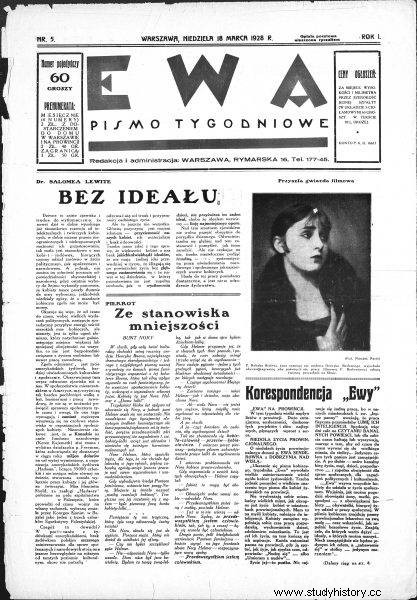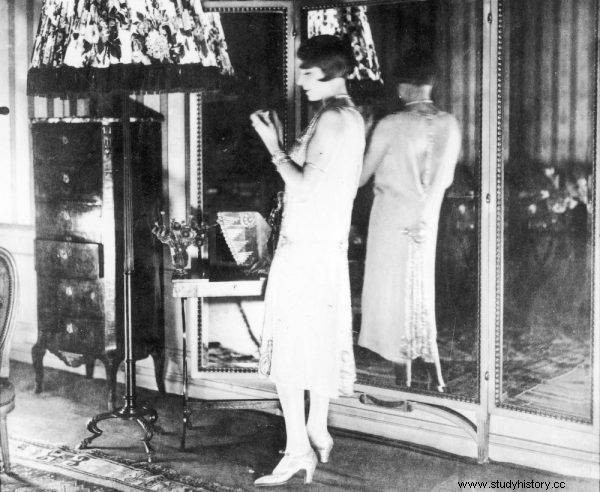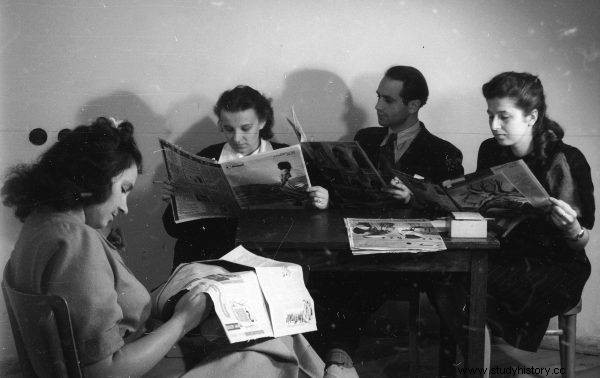One hundred years ago, the women's press experienced a real boom. What could our great-grandmothers find in the most popular titles? Some topics are still relevant today!
Diversity - the key word of the interwar period. Considering the nationality, for example:Poles constituted only less than 70% of the country's population. And this is generally speaking. Some regions, although formally belonging to the Second Polish Republic, were inhabited mainly by other nations. In addition, religious, class and political issues ... Hence the multitude of segments of the women's press. Including - minority magazines. The ladies could choose from around 200 titles. You can choose a color!
Magazines for everyone
Among the women's magazines in the interwar period, it was mainly "Ewa" that dominated . The weekly was published in the years 1928–1932, and one copy cost 30–60 groszy. In the case of subscriptions, readers, that is, first of all, emancipated Jewish women , paid about PLN 2 a month. The newspaper contained almost no illustrations. It mainly concerned the lives of women in Poland and Palestine, although there was of course information from around the world. On its pages we would find stories from divorce proceedings and issues related to the abortion law . The weekly magazine dealt with issues related to equal rights, the activities of famous, charismatic women and the position of female members in Jewish communities. On the other hand, fashion and beauty advice was given by the publishers marginally.

Among the women's magazines in the interwar period, it was mainly "Ewa" that dominated.
If not nationality, then politics. The titles oscillated around a few options. The Central Women's Department of the Polish Socialist Party published "Głos Kobiet", addressed primarily to female workers. People's party had, inter alia, "Voice to the Rural Women", and the national-Catholic - "Own Strengths". Sanacja letters appeared after the May coup. . Regardless of how politically and culturally different the titles were, most of them had a more or less emphasized equality in common. The editorial staff was mostly headed by women who wrote primarily for women . Which, given the rapidly changing economic situation, global sentiment and the mismatch between law and actual opportunities, posed many challenges.
Elegant and on time
The last cry of fashion according to "My Friend"? Furs and sashes. At least at the end of the third decade of the 20th century. The journal was published in the years 1934–1939, every two weeks. In it, we would most likely find the answer to what is worn this season. One issue cost 50 groszy, subscription is 80 groszy per month. What was the reader like? First of all - global and fashionable.
The thematic cross-section was wide - from social issues, successes achieved by women in Poland and around the world, through current cultural events, to recipes and beauty tips. In 1939, the section "Household in case of war" was added , and just a few issues later, the paper was discontinued. This chapter was intended to incite the readers to change their lifestyle. Because less than a year ago, the subject matter was completely different, and the pages of the magazine were full of splendor and elegance.
What could be found there? Even the most fashionable color (i.e. immortal black) and long scarves. Those in 1938 were a hit. In the August 10 issue of "My Friend" we read: Draped silk on the front and a wide sash with the ends falling to the ground, resembling an odalisque outfit [white slaves or concubines] from the Turkish harem. Very wide draped sashes are almost usually found in even short afternoon dresses made of wool; they will surely wash out heavily cluttered leather straps in a short time.

What was the reader of "My Friend" like? First of all - global and fashionable.
The most popular afternoon cut of the time was a plain, black, velvet dress below the knee, tied with a wide, colorful sash, one end of which reached below the edge. And among the evening models:silk costumes, satin dresses with wide or ruffled skirts, all embroidered with gold and silver threads. On top, of course, furs - three-quarter flared, with flared down sleeves and a fancifully cut, standing collar . Again, sports, walking and evening models were distinguished. Looking at the sheer variety of styles in "My Friend", it is easy to forget that over 70% of the population of the Second Polish Republic lived in the countryside.
"Feminine News" ... not very feminine?
In the opinion of emancipated women, definitely. Interestingly, the periodical published in the years 1931–1939 had a circulation of approximately 35,000 copies. Which is more than other, most famous magazines for ladies combined. Partly because of the price - after the increase it was only PLN 0.15. Partly due to the subject, which after three years of presence on the market, oscillated mainly around advice and entertainment. In "Women's News" there were, for example, "Psychoanalytical advice" clairvoyant. One cannot forget about the publishing house's policy aimed at the widest possible group of readers. This is where the "Popularna Press" company had experience - was one of the most widely read sensational journal of the time, "The Last News".
Over the years, "Wiadomości Kobiece" has been implementing sales trends that bring the best results. And so from the title initially about equality, they moved to a colorful magazine dominated by advice for housewives and gossip. This, in turn, caused the emancipated women circles to omit the newspaper in lists of valuable items. The editors noted in 1932 that the leaders of the Polish Radio announcements mention the venerable "Ivy", the honorable "Contemporary Woman", the beloved "Woman in the World and at Home", sinless "Ewa" and never Women's News.
Why? Well, Łucja Charewiczowa's answer to this question was brutal. It is an authority claiming to defend women's interests and rights in Poland , calling under male editors (...) all women working for the appeal, and for entertainment offering them light food of translated novels and learning card divination . The dispute did not end there. In response, the editors accuse him of crisis-refined content polite and worn . The "news", on the other hand, was supposed to go wherever where the carriage would not reach . And the title cannot be denied wide availability.
Immortal Ivy
The journal was established in 1865. In 1921 and 2008 it was reissued. In total, it has been on the market for over seven decades, and most of that time has been managed by women. If any magazine can be said to have raised successive generations of emancipated women, it is about "Ivy". They published in it, inter alia, Maria Konopnicka, Eliza Orzeszkowa, Maria Dąbrowska or Adam Asnyk.

The journal was established in 1865. In 1921 and 2008 it was reprinted.
In the years 1921–1939 the weekly cost 50 groszy. It was illustrated, the later issues even included photos from shows and exhibitions. But most of all - emancipation and literature. News from the world of culture? Ivy would be a good choice. It included, among others reviews, reports, excerpts from books or poetry. However, even a cultural magazine could not get away from home issues. Anyway, in 1924 the publishing house created additional titles:"Woman in the World and at Home", "Child and Mother" and "Kultura Ciała". Why?
Press in stride
One of the reasons was extremely down-to-earth - advertising. The more liberated press for women was most eager to take up the subjects of female MPs (or, as it was written then:"MP"), women's work and the related wage inequality or the international successes of Polish female artists. But advertisers were still interested in cosmetics and cleaning products . Hence, next to literary corners - laundry detergents.

Ladies could choose from about 200 titles. You can choose the color! (illustrative photo)
Besides, the vast majority of female readers simply needed and expected such content. When it comes to the position of women, the Second Polish Republic stood straddling. On the one hand, the well-known role of a hostess. On the other hand - the already tamed emancipationist movements, whose position was strengthened by first independence and later patriotic activities. Despite promoting paid work among women, it was a very unpopular opinion to say that a man would be a housekeeper. The situation was even different in the countryside, where women worked more than 20 days longer per year. It wasn't unusual to see a thirty-year-old looking like an old man.
Where's the ladies' magazines in all of this? Suspended between the various needs of female readers, editorial mission, and finances. And besides - with the necessity to adapt to the dynamic political situation and the constantly evolving new vision of femininity.
Sources:
- Chwastyk-Kowalczyk J., " Bluszcz" in the years 1918-1939 , Kielce 2003.
- "My Friend" August 10, 1938 [in:] polona.pl [accessed:January 8, 2022].
- Sierakowska K., Discussions on the influence of the war on the emancipation of women in the women's press of the interwar period [in:] "Recent History, Year LIII" (1).
- Sokół Z., Research on the women's press in 1818-1939 [in:] "Polish Press History Quarterly" 22 (3).
- Zdanowicz A, The issue of emancipation in the pages of "Wiadomości Kobiece" 1931-1933 , Warsaw 2017.
